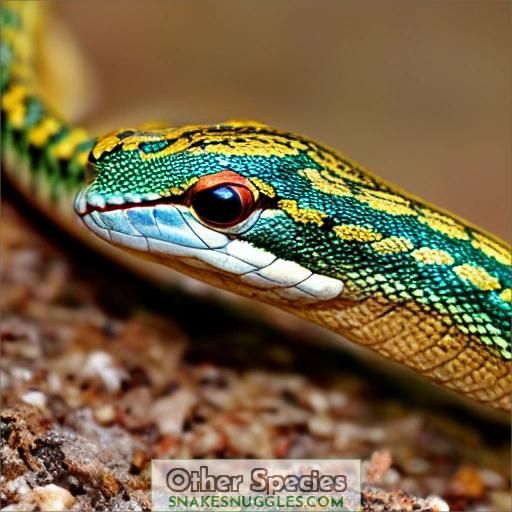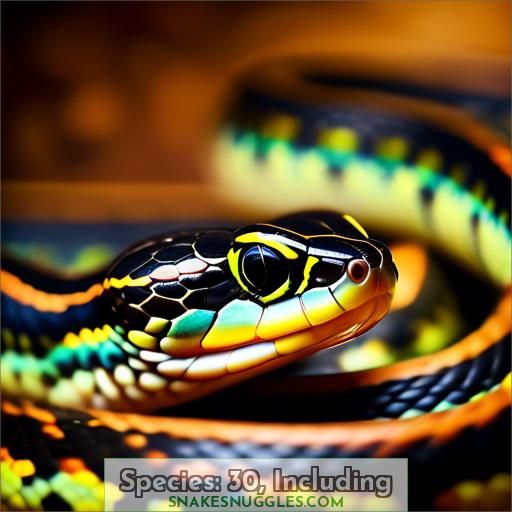This site is supported by our readers. We may earn a commission, at no cost to you, if you purchase through links.

You’re curious about the sizes of garter snakes, aren’t you?
Well, these reptiles exhibit a remarkable range, with over 30 species spanning from tiny to impressively long specimens.
The western ribbon snake measures just 16-28 inches.
The Mexican wandering garter snake can reach an astonishing 64 inches!
Sizes depend on factors like habitat and prey availability.
The common garter snake, widely distributed across North America, typically falls within 18-52 inches.
However, there’s much more variation to explore among these diverse serpents if you delve deeper.
Table Of Contents
- Key Takeaways
- How Big Do Garter Snakes Get All Well Known Species?
- Physical Characteristics
- Habitat
- Diet
- Life History
- Snakes and People
- Other Species
- Conservation Status
- Taxonomy/Classification
- Species: 30, Including
- Thamnophis Sirtalis (common Garter Snake)
- Thamnophis Sauritus (western Ribbon Snake)
- Thamnophis Proximus (western Ribbon Snake)
- Thamnophis Eques (Mexican Wandering Garter Snake)
- Thamnophis Mendax (southern Durango Spotted Garter Snake)
- Thamnophis Nigronuchalis (northwestern Garter Snake)
- Thamnophis Ordinoides (Tepalcatepec Valley Garter Snake)
- Thamnophis Postremus (western Ribbon Snake)
- Thamnophis Pulchrilatus (yellow-throated Garter Snake)
- Thamnophis Radix (plains Garter Snake)
- Thamnophis Rossmani (Rossman’s Garter Snake)
- Thamnophis Rufipunctatus (eastern Ribbon Snake)
- Thamnophis Sauritus (Mexican Alpine Blotched Garter Snake)
- Thamnophis Scalaris (Mesa Central Blotched Garter Snake)
- Thamnophis Scaliger (common Garter Snake)
- Thamnophis Sumichrasti (Sumichrast’s Garter Snake)
- Thamnophis Unilabialis (Mexican Pacific Lowlands Garter Snake)
- Thamnophis Validus (Mexican Pacific Lowlands Garter Snake)
- Frequently Asked Questions (FAQs)
- Conclusion
Key Takeaways
- Garter snakes exhibit a wide range of sizes, with species like the western ribbon snake measuring 16-28 inches and the Mexican wandering garter snake reaching 64 inches.
- The common garter snake, widely distributed across North America, typically falls within the range of 18-52 inches.
- Factors such as habitat and prey availability influence the size of garter snakes.
- Garter snakes are known for their ecological impact, controlling populations of amphibians and small mammals, and their saliva is toxic to amphibians, aiding in hunting.
How Big Do Garter Snakes Get All Well Known Species?
Garter snakes can vary greatly in size, with the common garter snake (Thamnophis sirtalis) being the most widely distributed species and having an average length of 55 cm (22 in) and an average weight of 150 g (5.3 oz) . Other well-known species of garter snakes include the eastern garter snake (Thamnophis sirtalis sirtalis), which is typically 18-26 inches (45.7-66 cm) long, and the western ribbon snake (Thamnophis sauritus), which is a slender snake with a length of up to 49 inches (124 cm) . The length of garter snakes can also depend on the subspecies, with some reaching up to 42 inches long.
Physical Characteristics
Garter snakes are a diverse group of reptiles, with over 30 species found throughout North America. These snakes are known for their distinctive striped pattern, which can vary in color from cream to orange, and their size can range from small to large. The common garter snake, Thamnophis sirtalis, is the most widespread species and can reach lengths of up to 63.7 inches (162 centimeters) . The giant garter snake, Thamnophis gigas, is another notable species, known for its impressive size and striking pattern.
The size of a garter snake can be influenced by its habitat adaptation and feeding strategy. For example, species found in wetter habitats, such as marshes and swamps, tend to be larger than those found in drier environments. Additionally, the availability of prey can impact a garter snake’s size, as larger snakes may require more food to sustain their growth.
Garter snakes are known for their ecological impact, as they help control populations of amphibians and small mammals. Their saliva is toxic to amphibians, which aids in their hunting strategy. These snakes are also opportunistic hunters, feeding on a variety of prey, including small fish, tadpoles, frogs, earthworms, and mice.
In terms of physical characteristics, garter snakes have a pattern of three light stripes on a dark body, with stripes that can be yellow, blue, green, or brown. The scales on their body are keeled, giving them a rough texture, and their belly is yellow and pale green. They’ve a long, slender body, which is well-suited for their agile movements and hunting abilities.
Habitat
Garter snakes, known for their distinctive striped pattern, inhabit a diverse range of habitats across North America. From marshes and sloughs to ponds and small streams, these snakes are found in a variety of wetland environments. They also thrive in agricultural wetlands such as rice fields and irrigation and drainage canals, which provide them with the necessary tall vegetation at the water’s edge and on the banks.
In urban areas, garter snakes can be found near water bodies, often in grassy or shrubby areas on the edges of water sources or in meadows and other openings nearby. Overwintering locations are typically terrestrial and can be far from foraging habitats. Many individuals use the same overwintering location.
The loss of habitat through infrastructure development and urbanization has contributed to the rapid loss and fragmentation of garter snake habitats. In response, conservation efforts have focused on preserving and restoring wetlands, which are essential for the survival of these snakes. For example, the East Contra Costa County Habitat Conservancy has been working to restore a 9-acre wetland that will support the recovery of listed species, including the giant garter snake.
Habitat restoration and enhancement are important for the survival of garter snakes and their prey species. This includes the use of managed grazing to increase the amount of grassland habitat available for the snakes, as well as the acquisition and preservation of suitable habitat. Private landowners can also play a role in conservation by creating frog ponds, providing native vegetation for cover and to connect adjacent habitat areas, and leaving gopher burrows intact.
Diet
Garter snakes are known for their diverse diet, which includes a variety of prey items that can vary depending on the species and their habitat. Here are three key points to explore when discussing the diet of garter snakes:
- Prey items: Garter snakes feed on a range of prey, such as amphibians (frogs, toads, and salamanders), fish, earthworms, and small mammals (mice, rodents, and birds) . Some species are even known to eat leeches, carrion, and slugs.
- Feeding habits: Garter snakes swallow their prey whole and don’t constrict it before consuming. They’re opportunistic hunters and will feed on whatever prey is available in their environment.
- Venom: While garter snakes don’t possess venom like some other snake species, their saliva can be toxic to amphibians, which can aid in the capture and immobilization of their prey.
Life History
Garter snakes’ life history is characterized by a gestation period lasting between 90 and 100 days, after which the females give birth to live young. Remarkably, these resilient reptiles don’t reproduce until they reach two years of age, a strategy that likely enhances their reproductive success and survival in the wild.
Gestation: the Gestation Period Lasts Between 90 and 100 Days
The gestation period of the red-sided garter snake lasts between 90 and 100 days.
During this time, the young develop within the female in a thin, sac-like membrane that contains a yolk.
The young are born live, and their size and number depend on the age, size, and condition of the female.
A typical litter ranges from 10 to 40 individuals, and the young receive no parental care after birth.
They disperse immediately upon birth.
This viviparous reproduction method has several advantages, including no predation of eggs and faster development of the young due to the warmer environment inside the female’s body.
The gestation period is relatively short, allowing the young to be born before the adults re-enter winter dormancy.
Age: Do Not Reproduce Until Two Years of Age
As a garter snake grows older, it becomes more mature and reaches its maximum size.
Garter snakes typically become sexually mature at 1.5 years for males and 2 years for females.
Once they reach this stage, their growth slows down, and they don’t grow much longer than their maximum size.
However, it’s important to note that garter snakes can continue to grow in length throughout their lives, although the rate of growth may decrease after reaching sexual maturity.
Snakes and People
Garter snakes are generally harmless to people. They have a mild temperament and are shy and non-aggressive. However, they can be found in yards and around outbuildings, where they may be encountered.
If you find a garter snake in your home, it can be easily removed with garden gloves. Garter snakes are not venomous, but their saliva is toxic to amphibians, which they use to subdue their prey.
Garter snake bites are rare and usually occur when the snake is handled or provoked. The San Francisco garter snake is an exception, as it is venomous and can cause a painful bite.
It is important to remember that all snakes, regardless of their venom, should be treated with respect and left alone.
Other Species
Garter snakes, a prevalent species found in North America, exhibit a range of color patterns and geographic distributions. While most garter snakes are renowned for their black body with yellow stripes, there are variations in color, including blue, green, and brown stripes. These snakes can be found from Maine to central Missouri and from central Ontario to Florida, adapting to a variety of habitats from dry to wet environments.
One of the most fascinating aspects of garter snakes is their venom differences. Unlike venomous snakes, garter snakes have toxic saliva that paralyzes their prey, primarily amphibians, earthworms, mice, small fish, and other small animals. Their saliva contains a toxin that affects the heart and muscles of their prey, making them an effective predator.
The habitat adaptations of garter snakes are remarkable. They’re found in a wide variety of habitats, from forests and grasslands to wetlands and urban areas. Their diet consists primarily of small mammals, ground squirrels, and aquatic prey, which they feed on during daylight hours. Garter snakes are viviparous, giving birth to live young, and they mate in March or April.
Conservation efforts are essential for garter snakes, as they’re a vital part of the ecosystem. While most garter snakes aren’t considered threatened, some populations may face challenges due to habitat loss and fragmentation. It’s imperative to preserve their habitats and monitor their populations to safeguard their continued existence.
Conservation Status
Garter snakes are a diverse group of reptiles found throughout North America, from Maine to central Missouri and from central Ontario to Florida. With over 30 species, the genus Thamnophis is home to these fascinating creatures, with the common garter snake (Thamnophis sirtalis) being the most well-known species. However, the conservation status of these snakes varies across their range.
Population trends for garter snakes are influenced by factors such as habitat loss, climate change, human impact, and the presence of invasive aquatic plants. For example, the giant garter snake (Thamnophis gigas) is listed as endangered in California, with threats including habitat destruction, over-collection for the commercial pet trade, and water pollution. In contrast, common garter snakes are considered abundant, but they’re often persecuted by humans, leading to declines in their populations due to pesticide use, habitat destruction, and over-collection.
Conservation efforts for garter snakes focus on protecting existing habitat, developing management plans for wetlands, and ensuring the availability of clean water during critical summer months. These strategies aim to support self-sustaining populations of giant garter snakes and restore healthy wetland ecosystems that support the species and associated species and communities of conservation concern.
In addition to the common garter snake, other species within the genus Thamnophis, such as the western ribbon snake (Thamnophis sauritus) and the Mexican wandering garter snake (Thamnophis eques), have their own conservation statuses and require specific conservation measures.
As we continue to study these fascinating creatures, it’s essential to monitor their populations and adapt conservation strategies based on the latest research and changing environmental conditions.
Taxonomy/Classification
The genus Thamnophis encompasses over 30 species of garter snakes, with the common garter snake (Thamnophis sirtalis) being one of the most widespread and well-known members of this genus. These snakes are characterized by their slender bodies adorned with longitudinal stripes, often in vibrant hues ranging from yellow to red, and their moderate sizes typically not exceeding 3 feet in length.
Genus: Thamnophis
As we venture deeper into the realm of garter snakes, let’s examine the classification of this captivating genus. Thamnophis, a genus within the Colubridae family, encompasses over 30 species, each possessing distinct traits. Three of these species are particularly notable:
- Thamnophis Sirtalis: The common garter snake, renowned for its striped pattern and checkered blotches, is a familiar species.
- Thamnophis Sauritus: The western ribbon snake, inhabiting diverse habitats, is an adept swimmer and a viviparous species.
- Thamnophis Proximus: Another western ribbon snake species, it’s also a viviparous snake and can be found in a range of habitats.
These species, along with others in the genus Thamnophis, shed their skin and exhibit colors ranging from cream to orange to olive brown to pale blue. So, what’s the size range of garter snakes? The answer depends on the specific species and their individual growth patterns.
Species: Thamnophis Sirtalis (common Garter Snake)
The common garter snake, Thamnophis sirtalis, is a versatile species found in various habitats, such as wetlands, forests, grasslands, and urban areas.
They feed on a diverse diet, primarily consisting of amphibians, fish, and small mammals.
Breeding occurs from March to April, and gestation lasts between 90 and 100 days.
However, their population has declined due to habitat loss from agricultural conversion and irrigation and drainage canals.
Despite their adaptability, they are listed as threatened.
Species: 30, Including
The Thamnophis genus contains around 30 species of garter snakes.
Notable ones include the common garter snake (Thamnophis sirtalis), reaching lengths up to 51 inches.
The western ribbon snake (Thamnophis proximus) grows around 28 inches.
The Mexican wandering garter snake (Thamnophis eques) averages 30 inches.
The southern Durango spotted garter snake (Thamnophis mendax) stretches to 35 inches.
The Mexican Pacific lowlands garter snake (Thamnophis validus) reaches lengths of 47 inches.
Exploring the diverse size ranges of these species provides insights into their adaptations to various habitats and ecological niches.
Thamnophis Sirtalis (common Garter Snake)
How Big Do Garter Snakes Get?
Garter snakes are a diverse group of reptiles, with the common garter snake (Thamnophis sirtalis) being one of the most widespread species in North America. These snakes are known for their distinctive striped pattern, which can vary in color from yellow to red, orange, brown, and black. But how big do garter snakes get? Let’s explore the size range of this fascinating species.
- Length:
Garter snakes can grow to a length of 86 cm (34 in), although most individuals are smaller. Females are generally larger than males and have longer tails. They’re typically black, brown, gray, or green, with three brightly colored stripes that match the color of their underside.
- Body Mass:
The average body mass of a garter snake is 150 g (5.3 oz).
- Subspecies Variations:
Some subspecies of garter snakes, such as the valley garter snake (Thamnophis sirtalis fitchi), can have a bright yellow dorsal stripe and bright red spots along the body.
- Hibernation and Predation:
Garter snakes are known for their ability to adapt to various environments. They can be found in a wide range of habitats, from meadows and marshes to woodlands and hillsides. During hibernation, they’re less active and more vulnerable to predation. To avoid this, garter snakes have evolved resistance to the powerful neurotoxin produced by the rough-skinned newt, which helps them survive in their environment.
- Adaptation and Camouflage:
Garter snakes have developed disruptive coloration, with their stripes serving as camouflage that makes them difficult for predators to spot. This adaptation helps them blend into their surroundings and avoid detection.
Thamnophis Sauritus (western Ribbon Snake)
As we journey further into the realm of garter snakes, let’s investigate the Western Ribbon Snake, Thamnophis sauritus. This species, also known as the western ribbon snake, is a member of the Thamnophis genus, which encompasses over 30 types of snakes found throughout North America. The Western Ribbon Snake is native to the western United States and Canada, and it’s recognized for its slender body and long, narrow tail.
The Western Ribbon Snake contributes to the genetic diversity of the Thamnophis genus. It inhabits various environments, including grasslands, wetlands, and forests. These snakes are adaptable and can be found in both rural and urban areas. They’re active during the day, and their diet primarily consists of small mammals, fish, and amphibians. They play a vital role in the ecosystem by controlling the populations of their prey species.
The Western Ribbon Snake is a viviparous species, meaning it gives birth to live young. Females carry their young within their bodies until they’re born, and they typically give birth in late summer. The litter size ranges from 4 to 27 young, with an average of 12. The young snakes are born fully developed and are independent from their mother after birth.
In terms of preservation, the Western Ribbon Snake is currently listed as a species of least concern by the International Union for Conservation of Nature (IUCN). However, like many other species, it’s affected by climate change and habitat loss. Habitat protection and conservation measures are indispensable to safeguarding the survival of this species and the other members of the Thamnophis genus.
As we continue to explore the realm of garter snakes, it’s imperative to comprehend the significance of genetic diversity and the role each species plays within its ecosystem. By gaining knowledge about these species and their habitats, we can take actions to protect them and guarantee their survival for future generations.
Thamnophis Proximus (western Ribbon Snake)
As you investigate the realm of garter snakes, let’s explore the intriguing subject of the Western Ribbon Snake, namely Thamnophis proximus. This species, prevalent throughout the western United States, Mexico, and Central America, is renowned for its diverse habitats and opportunistic feeding habits.
The Western Ribbon Snake is a slim snake with an exceptionally long tail, approximately one-third of its total body length. Its back color can vary from blackish, brown, or olive, adorned with three light-colored stripes. Its belly is greenish-white or yellowish-white. The upper lips are whitish and unblemished, while the head features a large, paired parietal spot and an elongated snout. Adults reach lengths of 17-50 inches (43-127 cm), including the tail.
This species is an active hunter that relies on its vision to locate amphibians, its main food source. It’s diurnal, primarily active during daylight hours, but may also hunt at night if temperatures permit. The Western Ribbon Snake is adaptable, consuming four species of fish, 23 species of frogs and toads, two species of salamanders, one species of lizard, one species of snake, and potentially earthworms in certain populations.
Regarding its habitat, the Western Ribbon Snake inhabits a wide range of environments, often in areas densely vegetated with nearby water sources such as streams, ponds, lakes, etc. It’s a semi-aquatic species and generally resides close to water. If disturbed, it will retreat into water or seek cover in dense vegetation or crevices. Its body coloration aids in its camouflage in these settings.
Conservation concerns for the Western Ribbon Snake include the loss and fragmentation of its habitats, as well as predation by non-native species. The species is currently classified as a species of least concern by the IUCN Red List.
As you continue your journey through the captivating world of garter snakes, bear in mind that each species possesses unique characteristics and adaptations that contribute significantly to their respective ecosystems.
Thamnophis Eques (Mexican Wandering Garter Snake)
The Mexican Wandering Garter Snake, Thamnophis eques, is a medium-sized garter snake with a maximum length of one meter. This species is found primarily in Arizona, with scattered populations historically present in southwestern New Mexico. The Mexican Wandering Garter Snake is a federally threatened wetland and riparian-obligate snake, and its critical habitat has been proposed but not yet finalized.
- Habitat Distribution: Mexican Wandering Garter Snakes are found in Southwest riparian areas with permanent water, in desert-grassland cienegas, in or along streams in valley floors, and occasionally in desert and lower oak woodland habitats.
- Behavior Patterns: This species is nonmigratory and breeds in fall and early spring, with females storing sperm until ovulation in late March or early April.
- Conservation Efforts: The Mexican Wandering Garter Snake is listed as a Threatened Species under the Endangered Species Act, and its population is declining in the United States, with many populations showing negative trends, low densities, and the possibility of extirpation.
The Mexican Wandering Garter Snake is a critical part of the wildlife in the Southwest, and its conservation is essential for maintaining the ecological balance of the region.
Thamnophis Mendax (southern Durango Spotted Garter Snake)
Delving into the realm of Thamnophis Mendax, you’re glimpsing into a domain where serpent size isn’t merely a figure—it’s a testament to adaptability.
Established in Southern Durango, these serpentine inhabitants showcase their habitat predilections with aplomb, flourishing amidst varied dietary choices.
Their narrative isn’t simply about survival; it’s a clarion call for conservation initiatives, highlighting the multifaceted tapestry of species diversity.
Thamnophis Nigronuchalis (northwestern Garter Snake)
The Northwestern Garter Snake, Thamnophis nigronuchalis, is a species found in the Nearctic region, specifically in the northwestern United States and southwestern Canada.
It inhabits a variety of habitats, including grasslands, forests, shrub-lands, and wetlands. The snake is most commonly found next to the wood line of a forest or thicket.
It has a striking appearance, with a body length ranging from 22.5 to 95 cm and a mass of 85 to 141 g. It has a vertebral stripe that runs the length of the body along the center of the dorsum, which can be a shade of yellow, orange, red, white, or blue.
Unlike some garter snakes, the Northwestern Garter Snake has an indistinct or absent lateral stripe. Small dark markings on scales surrounding the vertebral stripe are common.
The snake is a non-venomous predator, consuming prey such as amphibians, earthworms, and small fish. It’s a viviparous species, giving birth to live young. It reaches sexual maturity at two years of age.
Thamnophis Ordinoides (Tepalcatepec Valley Garter Snake)
The Tepalcatepec Valley Garter Snake, also known as Thamnophis Ordinoides, is a species native to the Tepalcatepec Valley in Mexico. Here are three interesting facts about this snake:
- Distribution patterns: This species is found in the Tepalcatepec Valley, a region known for its unique ecosystems and diverse wildlife.
- Size: Tepalcatepec Valley Garter Snakes are relatively small, with adults typically reaching lengths between 18 and 26 inches.
- Habitat: These snakes inhabit a variety of habitats, from dry to wet, and feed on a diet of amphibians, earthworms, mice, and other small animals.
Thamnophis Postremus (western Ribbon Snake)
The Western Ribbon Snake, a species belonging to the genus Thamnophis, is a slender snake found in North America. It’s typically 20 to 30 inches in length and has a striped pattern on its back, with the boldest stripe running over the spine. The snake’s juveniles resemble adults in their coloration, which is a gray to black dorsum with three yellowish stripes running down the length of the body. The belly is light colored, and the lip scales are white with no black outlines.
These snakes are found in a variety of habitats, including wetlands, wetland edges, and riparian zones of streams and rivers. They often climb in bushes overhanging water. Western Ribbon Snakes are semi-aquatic and prefer warmer temperatures, but can be active between 4 and 42 degrees Celsius, with 22-26 their preference.
The Western Ribbon Snake is a semi-aquatic species that’s most active during the day or during warm periods. It’s found in more brush-heavy habitats, close to water sources. They can also be found basking on rocks or flat vegetation, or in sandy, drier areas that are also close to water. This species is often confused with the Eastern Ribbon Snake, which has a very similar look and coloration. A few distinguishing characteristics include the reduction or absence of a broad, brown ventro-lateral stripe found on the Eastern species. The large paired parietal spots, longer muzzle, and tail on the Western Ribbon Snake are also a distinguishing feature.
Thamnophis Pulchrilatus (yellow-throated Garter Snake)
The yellow-throated garter snake (Thamnophis pulchrilatus) is a species of snake found in Mexico. It’s a small to moderate-sized snake, usually under 3 feet in length. The yellow-throated garter snake is known for its yellow throat, which distinguishes it from other garter snake species. This snake is found in various habitats, including forests, grasslands, wetlands, and urban areas.
In terms of size comparisons, the yellow-throated garter snake is relatively small compared to other garter snake species. For example, the common garter snake (Thamnophis sirtalis) can grow up to 54 inches (130 cm) in length. The yellow-throated garter snake’s geographic distribution is limited to Mexico, where it can be found in various states, including Durango, Guanajuato, Jalisco, Mexico State, Michoacan, Morelos, Oaxaca, Puebla, Queretaro, San Luis Potosi, Tlaxcala, Veracruz, and Zacatecas.
Conservation efforts for the yellow-throated garter snake are ongoing, as it’s a species of concern. The IUCN Red List doesn’t provide information on the conservation status of this species, but it’s mentioned that the species may eventually be found in the states of Sinaloa and Zacatecas. The yellow-throated garter snake is part of the genus Thamnophis, which includes 35 species of garter snakes.
Thamnophis Radix (plains Garter Snake)
The plains garter snake, also known as Thamnophis radix, is a medium-sized species of garter snake native to most of the central United States, stretching as far north as Canada and as far south as Northern Texas and New Mexico. This snake is characterized by its distinctive orange or yellow stripe running down its back, with the rest of its body being mainly a gray-green color. The plains garter snake is commonly found living near water sources such as streams and ponds, but can also be found in urban areas and vacant lots.
The plains garter snake is mildly venomous, although its venom isn’t toxic to humans. It’s described as one of the most cold-tolerant snakes, and is most active between April and late October, depending on location. Mating typically occurs in April or May, and young are born between August and October.
This species is found in a variety of habitats, including meadows and prairies adjacent to water sources, such as marshes, streams, and ponds. In urban and suburban areas, it has been observed in abandoned buildings, trash heaps, and vacant lots. The plains garter snake is listed as a species of least concern by the International Union for Conservation of Nature (IUCN).
In terms of conservation, the plains garter snake isn’t currently recognized as a subspecies, but it has faced challenges such as range contraction and competition with the more common gartersnake. Protection and restoration of remaining wet prairie habitat is essential for the survival of this species.
Thamnophis Rossmani (Rossman’s Garter Snake)
Thamnophis Rossmani, also known as Rossman’s Garter Snake, is a species endemic to Mexico. It’s found in the Mexican state of Nayarit and inhabits freshwater wetlands. This snake is viviparous, giving birth to live young. The specific name rossmani is in honor of the American herpetologist Douglas A. Rossman.
Rossman’s Garter Snake is a medium-sized snake, with a body length of about 60 cm (23.6 inches). They’re known for their slender build, making them more suitable for a terrarium. Preferred body temperatures for this species are estimated to be between 26-32°C (78-89.6°F).
In terms of conservation, Rossman’s Garter Snake isn’t currently listed as a threatened species. However, it’s important to preserve their habitats to warrant their continued survival. As with all wildlife, it’s essential to respect their natural habitats and avoid disturbing them unnecessarily.
Thamnophis Rufipunctatus (eastern Ribbon Snake)
The eastern ribbon snake, scientifically known as Thamnophis sauritus sauritus, is a slender, non-venomous snake native to the eastern United States and southeastern Canada. Adults can range from 16 to 28 inches in length, with a brown back and white belly, two light yellow lateral stripes, and a golden, brown, or yellowish orange middorsal stripe. The ribbon snake has a sequence of 19 keeled scales, which are rough to the touch with a ridge in the center of each scale, and lip scales that are uniformly yellowish or white with no markings between them.
The eastern ribbon snake is primarily found in moist environments such as wetlands, ponds, stream edges, rivers, and other sources of flowing and standing water. They prefer habitats with abundant vegetation for feeding and escaping from predators. During the spring, they’re most active when rainfall is abundant, but they can remain comfortable in unfavorable dry summers by utilizing burrows of common muskrat, round-tailed muskrat, crayfish, and other species.
The diet of the eastern ribbon snake consists mainly of frogs, but they also forage on other species of amphibians, insects, and fish. Throughout most of the year, they’re diurnal in their feeding pattern, but during the spring when frogs begin to breed, they become very active during night hours. Ribbon snakes are viviparous, giving birth to live young, and their brood sizes can range from 3 to 26, with 10 to 12 being most common.
Eastern ribbon snakes are considered to have a high population throughout their range, with low conservation concern. However, they’re affected by human development and disturbances in their habitat, such as water drainage sites that drain water sources for them, roads and highways that offer dangerous blockages for their populations, and climate change, which affects both the ribbon snake and its prey – amphibians.
Thamnophis Sauritus (Mexican Alpine Blotched Garter Snake)
Delve into the realm of Thamnophis sauritus, the Mexican Alpine Blotched Garter Snake, a testament to genetic variation. Its evolutionary narrative unfolds across Mexico’s highlands, where behavioral ecology weaves a tapestry of survival strategies. Amidst this, conservation efforts are paramount to protect its geographic range, ensuring the continued presence of this elusive serpent in nature’s intricate tapestry.
Thamnophis Scalaris (Mesa Central Blotched Garter Snake)
Thamnophis Scalaris, also known as the Mesa Central Blotched Garter Snake, is a small species of garter snake found in Mexico.
This snake has a maximum total length of 567 mm and is relatively stout-bodied compared to other species of garter snakes.
Its habitat is described as semi-arid desert-scrub valleys and oak forests at the lower portions of high mountain ranges.
It is an earthworm specialist, feeding primarily on this type of prey.
It has been observed to give birth to live young from mid-July to early September.
The litter sizes range from 10 to 46 individuals.
This snake is considered a rare and fascinating species, and its ecology and biology are not well researched.
Thamnophis Scaliger (common Garter Snake)
The common garter snake, Thamnophis scaliger, is a species of snake found in North America. It’s one of the most widespread snakes in the region and is known for its distinctive striped pattern. The snake’s size can vary, with adults typically ranging from 18 to 26 inches in length. The color of the snake can also vary, with adults having a dark body and three light stripes. The snake’s habitat is diverse, ranging from dry to wet environments, and it feeds on a variety of prey, including amphibians, earthworms, mice, and small fish.
The common garter snake is a viviparous species, meaning it gives birth to live young, and it doesn’t reproduce until it’s two years old. The snake isn’t considered a threat to humans and is actually beneficial in controlling populations of certain prey species. However, it’s important to note that the common garter snake isn’t suitable as a pet due to its specialized diet and habitat requirements.
The common garter snake is found throughout Connecticut and is native to North America, ranging from Maine to central Missouri and from central Ontario to Florida. The snake’s range is extensive, and it’s well adapted to a variety of habitats, making it a common sight in many areas.
Thamnophis Sumichrasti (Sumichrast’s Garter Snake)
The Sumichrasti garter snake, also known as Thamnophis Sumichrasti, is a species of garter snake found in California’s Central Valley. This species is known for its stripe patterns, which are similar to other garter snakes but may vary in color and pattern. The Sumichrasti garter snake typically has a light stripe running down its back, with two light-colored stripes on each side. Juvenile Sumichrasti garter snakes resemble adults, but their stripe patterns may be less distinct.
In terms of feeding habits, Sumichrasti garter snakes are opportunistic hunters that primarily feed on aquatic prey, such as small fish, tadpoles, and frogs. They’re also known to take advantage of small pools of water that trap prey and ambush their victims underwater. Sumichrasti garter snakes have been observed eating insects, small mammals, and birds.
These snakes are found in a variety of habitats, including marshes, sloughs, ponds, small lakes, and low-gradient streams. They require tall vegetation in the water, at the water’s edge, and on the banks for shelter and to provide a sense of security. Adjacent uplands are also important for basking and winter shelter.
Conservation measures for Sumichrasti garter snakes include protecting existing habitat, identifying and protecting areas for habitat restoration, enhancement, or creation, and providing connectivity between populations. Efforts are made to guarantee that these snakes have a reliable source of clean water during the critical active summer months.
In terms of physical characteristics, Sumichrasti garter snakes are small to moderate in size, usually under 3 feet in length. They’ve a striped pattern resembling a garter, with longitudinal stripes that can be yellow to red. Checkered blotches may be present between the stripes.
Thamnophis Unilabialis (Mexican Pacific Lowlands Garter Snake)
The Mexican Pacific Lowlands Garter Snake, or Thamnophis Unilabialis, is a species native to Mexico.
This snake is an aquatic species, spending most of its time near water. However, it also requires upland areas for basking and shelter.
Their habitat includes marshes, sloughs, ponds, small lakes, and small streams.
This species is listed as a threatened species due to habitat loss and fragmentation.
Conservation efforts are ongoing to safeguard their habitat and guarantee their survival.
Thamnophis Validus (Mexican Pacific Lowlands Garter Snake)
Thamnophis validus, commonly known as the West Coast Garter Snake, is a species of snake found in Mexico.
This snake species is medium-sized, with a length ranging from 165 mm to about 1100 mm.
The dorsal coloration of Thamnophis validus varies from brown to olive brown, while the ventral coloration is usually pale yellow without any darkening.
The snake has a single preocular and 3 postoculars. It has 130-140 ventrals in males and 127-139 in females. The subcaudals in males are 69-80, and 65-73 in females.
Frequently Asked Questions (FAQs)
What is the average length of a garter snake?
You’re looking at around 18-26 inches on average for a full-grown garter snake. But don’t be fooled – these little striped serpents pack a feisty personality in that compact body!
How many species of garter snakes are there?
You’re stepping into the enticing domain of garter snakes, where variety predominates. Get ready as around 35 distinct species glide through diverse terrains, each imbued with its own alluring allure.
What is the range of garter snakes in Canada?
You’ll find garter snakes across much of Canada, from British Columbia to Nova Scotia. Their range extends northward into the Yukon and Northwest Territories, reaching as far as the Arctic Circle in some areas. These widespread serpents thrive throughout most Canadian provinces and territories.
What is the diet of garter snakes?
You’re in for a treat! Garter snakes are opportunistic eaters, devouring anything from earthworms and leeches to amphibians and small mammals. Their diverse diet makes sure they thrive across various habitats. Talk about versatile hunters!
How do garter snakes reproduce?
You’ll find garter snakes are ovoviviparous – the female carries fertilized eggs inside her body and gives birth to live young. After mating in spring, she gestates for around 3-4 months before birthing 10-40 snakelets in late summer.
Conclusion
Satirically speaking, if you’re still unsatisfied with how large garter snakes get after exploring over 30 well-known species ranging from the minuscule 16-inch western ribbon snake to the colossal 64-inch Mexican wandering garter snake, you must be a true connoisseur of serpentine sizes.
This thorough guide leaves no slither unturned in detailing the remarkable size variations among these diverse reptiles adapted to their habitats and prey availability.















